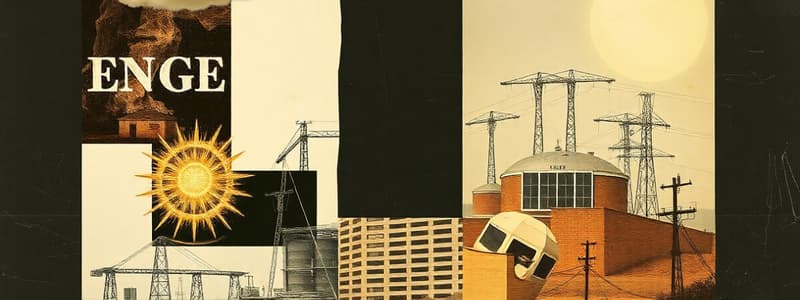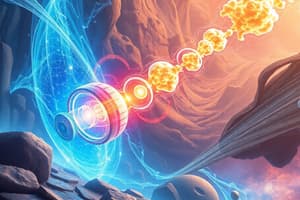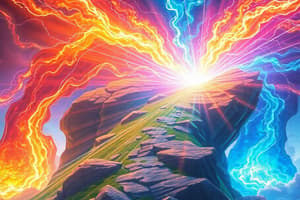Podcast
Questions and Answers
In a closed system, which of the following statements accurately describes the energy dynamics?
In a closed system, which of the following statements accurately describes the energy dynamics?
- Energy can enter, but not leave the system, leading to a gradual increase in total energy.
- The total energy of the system increases proportionally to external work performed.
- Energy can leave, but not enter the system, causing the total energy to diminish over time.
- The net change in the total energy of the system remains constant at zero. (correct)
Considering a scenario where a perfectly thermally insulated flask contains both a cold spoon and hot soup, what best describes the energy transfer within this closed system?
Considering a scenario where a perfectly thermally insulated flask contains both a cold spoon and hot soup, what best describes the energy transfer within this closed system?
- Energy is transferred from the thermal energy store of the soup to the thermal energy store of the spoon, resulting in the soup cooling slightly. (correct)
- Energy is transferred from the spoon to the soup, cooling the spoon and heating the soup until both reach the same temperature.
- No energy transfer occurs since the flask is perfectly insulated, and the initial temperature difference is maintained indefinitely.
- Energy is created within the soup due to chemical reactions and transferred to the spoon until thermal equilibrium.
A motor is specified to transfer 4.8 kJ of energy in 2 minutes. However, due to system inefficiencies, only 3.6 kJ is usefully transferred. Accounting for the energy losses, what strategies could be be employed to enhance the motor's performance and efficiency?
A motor is specified to transfer 4.8 kJ of energy in 2 minutes. However, due to system inefficiencies, only 3.6 kJ is usefully transferred. Accounting for the energy losses, what strategies could be be employed to enhance the motor's performance and efficiency?
- Apply aerodynamic streamlining to the motor's external structure.
- Implement effective lubrication systems and improve thermal insulation to minimize energy dissipation. (correct)
- Use materials with higher thermal conductivity in the motor's construction.
- Increase the motor's operational time to compensate for energy losses.
A hypothetical device intakes 100 J of electrical energy, from which 60 J is converted into kinetic energy and 20 J into gravitational potential energy. Given the energy conservation principle, what accounts for the remaining 20 J?
A hypothetical device intakes 100 J of electrical energy, from which 60 J is converted into kinetic energy and 20 J into gravitational potential energy. Given the energy conservation principle, what accounts for the remaining 20 J?
The conservation of energy principle dictates that while energy can be transferred usefully, stored, or dissipated, it can also be spontaneously created under specific conditions.
The conservation of energy principle dictates that while energy can be transferred usefully, stored, or dissipated, it can also be spontaneously created under specific conditions.
Which of the following scenarios exemplifies energy transfer primarily through heating?
Which of the following scenarios exemplifies energy transfer primarily through heating?
Electromagnetic radiation, such as light, exclusively transfers energy via particle collision.
Electromagnetic radiation, such as light, exclusively transfers energy via particle collision.
A perfectly elastic ball is dropped from a height of 10 meters. If air resistance is negligible, describe the energy transformations that occur until the ball reaches its lowest point.
A perfectly elastic ball is dropped from a height of 10 meters. If air resistance is negligible, describe the energy transformations that occur until the ball reaches its lowest point.
Explain the energy transfers involved when a vehicle's brakes are applied, detailing how the kinetic energy is ultimately dissipated.
Explain the energy transfers involved when a vehicle's brakes are applied, detailing how the kinetic energy is ultimately dissipated.
Describe how cavity wall insulation minimizes energy transfer and identify the primary modes of heat transfer it aims to reduce.
Describe how cavity wall insulation minimizes energy transfer and identify the primary modes of heat transfer it aims to reduce.
In the context of lifting an object in a gravitational field, what variable is least influential in determining the gravitational potential energy (GPE) stored?
In the context of lifting an object in a gravitational field, what variable is least influential in determining the gravitational potential energy (GPE) stored?
Which of the following materials would most effectively transfer energy through conduction?
Which of the following materials would most effectively transfer energy through conduction?
A material with a high specific heat capacity requires less energy to achieve a substantial temperature change relative to a material with a low specific heat capacity, assuming equal mass.
A material with a high specific heat capacity requires less energy to achieve a substantial temperature change relative to a material with a low specific heat capacity, assuming equal mass.
A calorimeter contains 2.0 kg of water at 20°C. A 500 W heater is submerged in the water for 5 minutes. Assuming no heat is lost to the surroundings (closed system), what is the final temperature of the water, considering the specific heat capacity of water is 4200 J/kg°C?
A calorimeter contains 2.0 kg of water at 20°C. A 500 W heater is submerged in the water for 5 minutes. Assuming no heat is lost to the surroundings (closed system), what is the final temperature of the water, considering the specific heat capacity of water is 4200 J/kg°C?
Which of the following scenarios best illustrates energy transfer through convection?
Which of the following scenarios best illustrates energy transfer through convection?
According to Bohr's model, electrons orbiting the nucleus exist at specific, quantized distances, also known as _______ _______, which agrees with experimental data.
According to Bohr's model, electrons orbiting the nucleus exist at specific, quantized distances, also known as _______ _______, which agrees with experimental data.
According to Rutherford's gold foil experiment, what crucial deduction led to the proposal that most of the atom is empty space?
According to Rutherford's gold foil experiment, what crucial deduction led to the proposal that most of the atom is empty space?
How did James Chadwick's discovery of the neutron refine the understanding of atomic structure relative to earlier models?
How did James Chadwick's discovery of the neutron refine the understanding of atomic structure relative to earlier models?
Given that isotopes are forms of the same element with different numbers of neutrons, which physical property remains consistent among all isotopes of a given element?
Given that isotopes are forms of the same element with different numbers of neutrons, which physical property remains consistent among all isotopes of a given element?
Explain why alpha radiation is considered strongly ionizing despite having limited penetration depth.
Explain why alpha radiation is considered strongly ionizing despite having limited penetration depth.
If alpha, beta, and gamma radiation are passed through an electric field, how would their trajectories differ due to their nature and composition?
If alpha, beta, and gamma radiation are passed through an electric field, how would their trajectories differ due to their nature and composition?
Gamma rays are most effectively blocked by thin sheets of aluminum due to their high interaction rate with electrons in the aluminum atoms.
Gamma rays are most effectively blocked by thin sheets of aluminum due to their high interaction rate with electrons in the aluminum atoms.
What underlying principle explains why a compass needle aligns with the Earth's magnetic field rather than with a nearby artificial magnetic field of comparable strength?
What underlying principle explains why a compass needle aligns with the Earth's magnetic field rather than with a nearby artificial magnetic field of comparable strength?
The compass aligns with the magnetic field because inside, there is a tiny ____ _____ whose north pole aligns with the south pole of any other magnet it is near.
The compass aligns with the magnetic field because inside, there is a tiny ____ _____ whose north pole aligns with the south pole of any other magnet it is near.
Which factor most critically determines the strength of the force experienced by a conductor carrying a current through a magnetic field?
Which factor most critically determines the strength of the force experienced by a conductor carrying a current through a magnetic field?
Using Fleming's left-hand rule, how does reversing both the magnetic field direction and the current direction impact the force experienced by the conductor?
Using Fleming's left-hand rule, how does reversing both the magnetic field direction and the current direction impact the force experienced by the conductor?
If a wire lies parallel to the magnetic field, the wire experiences the maximum possible force.
If a wire lies parallel to the magnetic field, the wire experiences the maximum possible force.
When a current flows through a wire, it creates a magnetic field. How does increasing the current affect the magnetic field's characteristics?
When a current flows through a wire, it creates a magnetic field. How does increasing the current affect the magnetic field's characteristics?
What geometric configuration optimally increases the strength of the magnetic field produced by a current-carrying wire?
What geometric configuration optimally increases the strength of the magnetic field produced by a current-carrying wire?
Match each type of radiation with its corresponding composition and typical penetrating power:
Match each type of radiation with its corresponding composition and typical penetrating power:
Explain thermal conductivity as a property and how materials with high or low thermal conductivity affect energy transfer.
Explain thermal conductivity as a property and how materials with high or low thermal conductivity affect energy transfer.
Differentiate between permanent and induced magnets in terms of their magnetic properties and behavior.
Differentiate between permanent and induced magnets in terms of their magnetic properties and behavior.
Energy is transferred mechanically when a force does ___, electrically when work is done by _______ charges, and through _______, such as light.
Energy is transferred mechanically when a force does ___, electrically when work is done by _______ charges, and through _______, such as light.
How does the kinetic energy of an object vary with its mass and velocity, as described by the kinetic energy formula?
How does the kinetic energy of an object vary with its mass and velocity, as described by the kinetic energy formula?
Lubricants increase friction between two surfaces by creating a microscopic layer of adhesive material.
Lubricants increase friction between two surfaces by creating a microscopic layer of adhesive material.
Which scenario best exemplifies the principle of convection currents?
Which scenario best exemplifies the principle of convection currents?
How do double-glazed windows reduce heat transfer compared to single-pane windows?
How do double-glazed windows reduce heat transfer compared to single-pane windows?
According to the efficiency equation, what two variables must be known to accurately calculate the efficiency of any energy transfer?
According to the efficiency equation, what two variables must be known to accurately calculate the efficiency of any energy transfer?
A kettle transfers electrical energy to the thermal energy store of water, causing its _______ to rise.
A kettle transfers electrical energy to the thermal energy store of water, causing its _______ to rise.
Electromagnets are utilized in electric starters of motors to act as switches. Elucidate the process.
Electromagnets are utilized in electric starters of motors to act as switches. Elucidate the process.
A force will be exerted on a conductor in a magnetic field given that the conductor is at a ___ degree angle to the magnetic field, otherwise ___ force is transferred.
A force will be exerted on a conductor in a magnetic field given that the conductor is at a ___ degree angle to the magnetic field, otherwise ___ force is transferred.
Flashcards
Energy Transfer
Energy Transfer
Energy is transferred between energy stores and different objects.
Energy Stored
Energy Stored
Energy moves from one of an object's energy stores to another.
Types of Energy Stores
Types of Energy Stores
Thermal, kinetic, gravitational potential, elastic potential, chemical, magnetic, electrostatic, nuclear
Energy Transfer Types
Energy Transfer Types
Signup and view all the flashcards
What is a system?
What is a system?
Signup and view all the flashcards
System Energy Changes
System Energy Changes
Signup and view all the flashcards
Closed System
Closed System
Signup and view all the flashcards
Energy in Closed System
Energy in Closed System
Signup and view all the flashcards
Energy Transfer by Heating
Energy Transfer by Heating
Signup and view all the flashcards
Work done
Work done
Signup and view all the flashcards
Throwing a Ball
Throwing a Ball
Signup and view all the flashcards
Dropping a Ball
Dropping a Ball
Signup and view all the flashcards
Car Brakes
Car Brakes
Signup and view all the flashcards
Car Collision
Car Collision
Signup and view all the flashcards
Kinetic Energy Store
Kinetic Energy Store
Signup and view all the flashcards
Kinetic Energy Factors
Kinetic Energy Factors
Signup and view all the flashcards
Kinetic Energy Formula
Kinetic Energy Formula
Signup and view all the flashcards
Raised Object Energy
Raised Object Energy
Signup and view all the flashcards
GPE Factors
GPE Factors
Signup and view all the flashcards
GPE formula
GPE formula
Signup and view all the flashcards
Falling Object Energy
Falling Object Energy
Signup and view all the flashcards
Elastic Energy Store
Elastic Energy Store
Signup and view all the flashcards
Specific Heat Capacity
Specific Heat Capacity
Signup and view all the flashcards
Specific Heat
Specific Heat
Signup and view all the flashcards
Conservation of Energy
Conservation of Energy
Signup and view all the flashcards
Dissipated Energy
Dissipated Energy
Signup and view all the flashcards
Wasted energy
Wasted energy
Signup and view all the flashcards
Power Definition
Power Definition
Signup and view all the flashcards
Power Formula
Power Formula
Signup and view all the flashcards
Conduction
Conduction
Signup and view all the flashcards
Convection
Convection
Signup and view all the flashcards
Lubrication
Lubrication
Signup and view all the flashcards
Thermal Insulation
Thermal Insulation
Signup and view all the flashcards
Efficiency
Efficiency
Signup and view all the flashcards
Plum Pudding Model
Plum Pudding Model
Signup and view all the flashcards
Nucleus
Nucleus
Signup and view all the flashcards
Ionising Radiation
Ionising Radiation
Signup and view all the flashcards
Alpha particle
Alpha particle
Signup and view all the flashcards
Beta Particle
Beta Particle
Signup and view all the flashcards
Gamma Rays
Gamma Rays
Signup and view all the flashcards
Study Notes
- Energy is never used up but is transferred between energy stores and different objects.
Energy is Transferred Between Stores
- When energy is transferred to an object, it is stored in one of the object's energy stores.
- The energy stores are thermal, kinetic, gravitational potential, elastic potential, chemical, magnetic, electrostatic and nuclear energy stores.
- Energy is transferred mechanically (by a force doing work), electrically (work done by moving charges), by heating or by radiation.
When a System Changes, Energy is Transferred
- A system is a single object or a group of objects that you're interested in.
- When a system changes, energy is transferred into or away from the system, between different objects in the system or between different types of energy stores.
- Closed systems are systems where neither matter nor energy can enter or leave.
- The net change in the total energy of a closed system is always zero.
Energy can be Transferred by Heating
- Energy can be transferred by heating from a kettle's heating element to the thermal energy store of water, causing the water temperature to rise.
- This can be seen as a two-object system including the kettle's heating element and the water. Energy is transferred electrically to the thermal energy store of the kettle's heating element, which transfers energy by heating to the water's thermal energy store.
Energy can be Transferred by Doing Work
- Work done is another way of saying energy transferred.
- Work can be done when current flows or by a force moving an object
Examples of Energy Transfer by Doing Work
- The force exerted by a person to throw a ball upwards does work transferring chemical energy the person's arm to the kinetic energy store of the ball and arm.
- A ball dropped from a height is accelerated by gravity, the gravitational force does work, transferring the gravitational potential energy to its kinetic energy store.
- The friction between a car's brakes and its wheels does work as it slows down, transferring kinetic energy to the thermal energy store of the surroundings.
- In a collision between a car and a stationary object, the normal contact force does work, transferring kinetic energy to other energy stores, e.g. elastic potential and thermal energy stores of the object and the car body. Some energy might also be transferred away by sound waves.
Kinetic and Potential Energy Stores
- Kinetic energy stores relate to movement and depends on mass and speed.
- Gravitational potential energy stores relate to raised objects in a gravitational field and depends on mass, height, and the strength of the gravitational field.
- Elastic potential energy stores relate to stretching or squashing an object.
Movement Means Energy in an Object's Kinetic Energy Store
- Anything moving has energy in its kinetic energy store
- The greater the mass and speed, the more energy in the kinetic energy store.
- Ek = 1/2mv², where Ek is kinetic energy (J), m is mass (kg), and v is speed (m/s).
Raised Objects Store Energy in Gravitational Potential Energy Stores
- Lifting an object in a gravitational field requires work, transferring energy to the gravitational potential energy store.
- The higher the object is lifted, the more energy is transferred to this store.
- Ep = mgh, where Ep is gravitational potential energy (J), m is mass (kg), g is gravitational field strength (N/kg), and h is height (m).
Falling Objects Also Transfer Energy
- When something falls, energy from its gravitational potential energy store is transferred to its kinetic energy store.
- For a falling object with no air resistance energy lost from the GPE store is equal to energy gained in the Kinetic energy store.
- In real life, air resistance causes some energy to be transferred to other energy stores such as the thermal energy stores.
Stretching Can Transfer Energy to Elastic Potential Energy Stores
- Stretching or squashing an object can transfer energy to its elastic potential energy store.
- Ee = 1/2ke², where Ee is elastic potential energy (J), k is the spring constant (N/m), and e is the extension (m).
Specific Heat Capacity
- Specific heat capacity is a measure of how hard it is to heat something up.
Different Materials Have Different Specific Heat Capacities
- More energy needs to be transferred to increase the temperature of some materials than others.
- Specific heat capacity is the energy needed to raise the temperature of 1 kg of a substance by 1°C.
- ΔE = mcΔΘ, where ΔE is the change in thermal energy (J), m is mass (kg), c is specific heat capacity (J/kg°C), and ΔΘ is the change in temperature (°C).
Conservation of Energy and Power
- Energy is never destroyed and the conservation of energy principle is that energy is always conserved.
- When energy is transferred between stores, some energy is always dissipated, often as 'wasted energy' in thermal energy stores.
Power is the 'Rate of Doing Work'
- Power is the rate of energy transfer, or the rate of doing work, and is measured in watts (one watt = 1 joule of energy transferred per second).
- P = E/t, where P is power (W), E is energy transferred (J), and t is time (s).
- P = W/t where P is power (W), W is work done (J), and t is time (s).
- A powerful machine transfers a lot of energy in a short space of time.
Conduction and Convection
- Conduction and convection explain energy transfers by heating.
Conduction Occurs Mainly in Solids
- Conduction is where vibrating particles transfer energy to neighboring particles.
- Energy transferred by heating is transferred to an object's thermal store, shared across the kinetic energy stores of the particles and the particles vibrate more and collide with each other, transferring energy, until energy is transferred to the surroundings.
- Thermal conductivity is a measure of how quickly energy is transferred through a material.
Convection Occurs Only in Liquids and Gases
- Convection is where energetic particles move away from hotter to cooler regions.
- Energy transferred by heating is transferred to the thermal store and is shared across the kinetic energy stores and when a region is heated the particles move faster and space between them increases, therefore decreasing density.
- The warmer and less dense region will rise above denser, cooler regions creating a convection current.
Radiators Create Convection Currents
- Radiators create convection currents in the air.
- Energy is transferred from the radiator to the nearby air particles by conduction, the air warms, becomes less dense and rises.
- Cooler air replaces the warmer air, the air transfers energy to the surroundings, cools, becomes denser and sinks, repeating this cycle.
Reducing Unwanted Energy Transfers
- Reduce the amount of energy scampering off to a completely useless store using lubrication and thermal insulation.
Lubrication Reduces Frictional Forces
- Whenever something moves, there's usually at least one frictional force, causing energy dissipation.
- Lubricants reduce friction between objects' surfaces.
Insulation Reduces the Rate of Energy Transfer by Heating
- Prevent energy losses through heating by using thick walls with low thermal conductivity, and thermal insulation.
- Some houses have cavity walls, which reduce energy transfer by conduction, or cavity wall insulation to reduce convection.
- Loft insulation can reduce convection currents and double glazed windows prevent conduction.
- Draught excluders reduce energy transfers by convection
Efficiency
- Efficiency is the ratio of useful energy output to total energy input.
Most Energy Transfers Involve Some Waste Energy
- Useful devices transfer energy from one store to another.
- Some of the input energy is wasted, usually to a thermal energy store.
- The less energy wasted, the more efficient the device.
- Improve efficiency by insulating, lubricating or streamlining.
- Efficiency = (Useful output energy transfer) / (Total input energy transfer)
- Efficiency = (Useful power output) / (Total power input)
Useful Energy Input Isn't Usually Equal to Total Energy Output
- Remember no device is 100% efficient and wasted energy is usually transferred to thermal energy stores.
- Electric heaters are the exception usually being 100% efficient because the energy in the electrostatic energy store is transferred.
- Ultimately, all energy ends up transferred to thermal energy stores.
Developing the Model of the Atom
- Early atomic models include Dalton's solid sphere, Thomson's plum pudding model with electrons in a positive charge sphere.
- Rutherford's alpha scattering experiment showed a concentrated positive nucleus.
- This was developed into Bohr's model with electrons orbiting at specific energy levels.
- Chadwick discovered the neutron.
Rutherford Replaced the Plum Pudding Model with the Nuclear Model
- In 1804 John Dalton agreed with Democritus that matter was made up of finy spheres ("atoms") that couldn't be broken up, but he reckoned that each element was made up of a different type of "atom".
- Nearly 100 years later, J. J. Thomson discovered particles called electrons that could be removed from atoms, forming the plum pudding model of the atom.
- In 1909 scientists in Rutherford's lab tried firing a beam of alpha particles at thin gold foil in the alpha scattering experiment.
- From the plum pudding model, they expected the particles to pass straight through the gold sheet, or only be slightly deflected, this was not the case.
- Most of the mass of the atom must be concentrated at the centre in a tiny nucleus that had a positive charge with most of an atom as empty space, the first nuclear model of the atom.
Which Developed into the Current Model of the Atom
- The nuclear model that resulted from the alpha particle scattering experiment was a positively charged nucleus surrounded by a cloud of negative electrons.
- Niels Bohr said that electrons orbiting the nucleus do so at certain distances called energy levels described through theoretical calculations that agreed with experimental data.
- Evidence from further experiments changed the model to have a nucleus made up of a group of particles (protons) which all had the same positive charge that added up to the overall charge of the nucleus.
- About 20 years after the idea of a nucleus was accepted, in 1932, James Chadwick proved the existence of the neutron, which explained the imbalance between the atomic and mass numbers (page 44).
The Current Model of the Atom
- The nucleus is tiny but makes up most of the mass of the atom containing protons and neutrons.
- Its radius is about 10000 times smaller than the radius of the atom
- Electrons give the atom its overall size, they move within energy leaving charged ions.
Isotopes and Nuclear Radiation
- Isotopes and ionisation are similar.
- Isotopes are Different Forms of the Same Element.
- Isotopes are atoms of the same element with the same number of protons but a different number of neutrons.
- Unstable isotopes will decay into other elements and give out radiation called radioactive decay of alpha, beta and gamma radiation.
- Alpha particles are two neutrons and two protons like a helium nucleus that don't penetrate far.
- Beta particles are high speed electrons being moderately ionising.
- Gamma rays are EM waves with a short wavelength that penetrate far.
Permanent and Induced Magnets
- Magnets Produce Magnetic Fields.
- Magnets have north and south poles producing magnetic fields.
- The magnetic field is strongest at the poles and you can show the magnetic field by drawing magnetic field lines going north to south .
- Compasses show the directions of Magnetic Fields.
Magnets Can be Permanent or Induced
- There are two types of magnet permanent magnets and induced magnets.
- Permanent magnets produce their own magnetic field.
- Induced magnets are magnetic materials that turn into a magnet when they're put into a magnetic field attracted to permanent magnets.
- When taking away the magnetic field, induced magnets quickly lose their magnetism.
Electromagnetism
- A magnetic field is also found around a wire that has a current passing through it.
A Moving Charge Creates a Magnetic Field
- When a current flows through a wire, a magnetic field is created around the wire.
- The field is made up of concentric circles perpendicular to the wire, with the wire in the centre.
- Changing the direction of the current changes the direction of the magnetic field using the right-hand thumb rule.
- The larger the current through the wire, or the closer to the wire you are, the stronger the field is.
A Solenoid is a Coil of Wire
- Increase the strength of the magnetic field that a wire produces by wrapping the wire into a coil called a solenoid.
- The field lines around each loop of wire line up with each other, creating lots of field lines pointing in the same direction that are very close to each other.
- The magnetic field inside a solenoid is strong and uniform and putting a block of iron in the centre of the coil increases the field strength.
- If stopping the current, the magnetic field disappears, with it a solenoid with an iron core (a magnet whose magnetic field can be turned on and off with an electric current) is called an ELECTROMAGNET.
Electromagnets Have Lots of Uses
- Electromagnets are used to quickly turn on and off , creates a a varying force, and switches.
The Motor Effect
- The motor effect can happen when you put a current-carrying wire in a magnetic field.
A Current in a Magnetic Field Experiences a Force
- When a current-carrying wire is put between magnetic poles, causes the magnet and the conductor to exert a force on each other due to the magnetic fields interaction (called the motor effect).
- To experience the full force, the wire has to be at 90° to the magnetic field.
- The force always acts at right angles to the magnetic field of the magnets and the direction of the current in the wire.
- The magnitude (strength) of the force increases with the strength of the magnetic field and the amount of current passing through the conductor.
- The force acting on a conductor in a magnetic field depends on magnetic flux density, current and length of conductor.
Finding the Size of the Force
- Found by using the equation F = BIl, where F is force (N), B is magnetic flux density (T, tesla), I is current (A) and l is length (m).
- Use Fleming's left-hand rule, pointing your First finger in the direction of the Field and your second finger in the direction of the Current, your thumb will then point in the direction of the force (Motion).
Studying That Suits You
Use AI to generate personalized quizzes and flashcards to suit your learning preferences.




